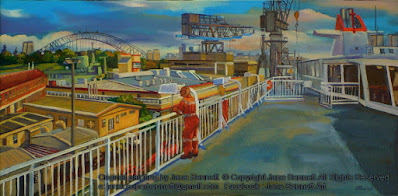Today's painting on the easel of my deck gallery is a 2009 plein air oil painting of a derelict abandoned old shop in Pyrmont, fondly, but wrongly known as the "old bakery".
 |
| P257A 'Old milkbar aka 'bakery' corner of John and Harris St' 2009 oil on canvas 51 x 61cm Available |
As far as I can remember the actual bakery was a few doors down and the corner shop was a milkbar, but we're talking at least 3 decades ago.
My standout memory of it when it was in its last days of operation was how rubbish I was at playing their "Fussball" machine, which was lines of wooden footballers attached to a stick that you tried to manoeuver by a lever to kick the ball.
Not a single goal!
Not a single goal!
The legendary Terminus Hotel on the opposite side of Harris Street, and like its more famous counterpart, was part of the Wakil's real life Monopoly game. They had a landbanking empire of quirky, derelict buildings which were loathed by local residents as eyesores but cherished by artists like myself.
Aren't Artists a perverse bunch - we ignore all the shiny new developments and make straight for the 'shame of the neighbourhood' to immortalize it!
 |
| P257A 'Old milkbar aka 'bakery' corner of John and Harris St' 2009 oil on canvas 51 x 61cm Available |
The continuous row of 19th century 2 storey terrace houses between Nos 74 and 80 Harris Street are still part of the Wakil collection of formerly derelict buildings, which once included the iconic Terminus Hotel opposite.
The row of terraces have rendered brick shopfronts and skillion roofed wings at the rear. They are plainly detailed, with only a string course to the facades as decoration, and a Victorian/Georgian flavour in their design. Door openings are rectangular, and window openings are also rectangular as well as slightly segmentally arched. They are without parapet or verandahs and feature corrugated iron gable roofs with low corniced or corbelled chimneys.
 |
| P256A 'Old Milkbar (aka 'Bakery'), corner of Harris and John St' 2009 acrylic on paper 21 x 28cm Available |
No 74 is similar to the rest, but was a corner shop and is faceted with a corner entrance. It was a milkbar for a long time, although often and wrongly referred to as the 'old bakery'.
Number 82 was the actual site of the "old bakery", although now the entire block seems to have adopted this name.
Number 82 was the actual site of the "old bakery", although now the entire block seems to have adopted this name.
For many years the corner and north facing doorways were boarded up and featured an endless layering of illegal posters promoting long forgotten bands.
 |
| P256B 'Old Milkbar and 'Chicks on Harris'' 2009 acrylic on paper 21 x 28cm Available |
Until about 2014, No 82 still partly kept up the milk bar tradition,traded as a "charcoal chicken" outlet called "Chicks on Harris".
Bearing in mind the seedy reputations of previous establishments at the north end of Harris St, I'm not sure that the owners had really thought through the implications of their name!
Milk bars are now imbued with mythical qualities they never possessed in life. In decline and death, they’re trendy and retro.

P256 'Black Dog (old milkbar -
aka 'bakery' from John St)'
2009 oil on board 31 x 25cm
Available
No 74 has now been recently and very sympathetically redeveloped by the current occupants - appropriately, 'Belle Property' real estate agents. And now it really is a 'belle' property indeed.
It's been painted a tasteful off-white shade, and the former layers of peeling posters have been replaced by large picture windows.
I couldn't resist having a sneaky peek inside.
The interior still has the original wall material visible, and the beautiful old hardwood stairs have been polished, but otherwise in their original state. The architraves are dark walnut stained hardwood, but the rotting floors had collapsed long ago and had to be replaced with polished concrete.
The huge tree outside is a relic from when both sides of John Street were edged with a row of trees whose branches would meet in the middle of the street to form a cathedral-like canopy. Lush and cool in summer, but most beautiful in winter when the feeble rays of the sun would pierce through the tracery of bare branches.
A lovely tree, but its roots went straight for the plumbing, and the pavement outside is cracked and humped by the twisting roots underneath. I know that a few years ago, several people had considered this old shop on as a renovation project, but weren't quite crazy-brave enough to take it on.
For more information about Harris and John Street in Pyrmont, including the Terminus and Pyrmont Point Hotels
see My Pyrmont page in this blog
Related posts
Looking over the overlooked-Urban decay in Pyrmont
To the Point
Wrong side of the tracks - Darling Island Bond and Free
Pretty vacant
A Tale of two hotels - the Terminus and the Point
The bad twin of Pyrmont Street
Pyrmont Paintings past and present

















